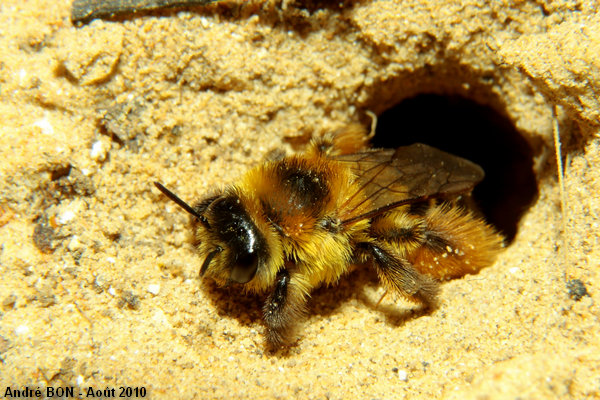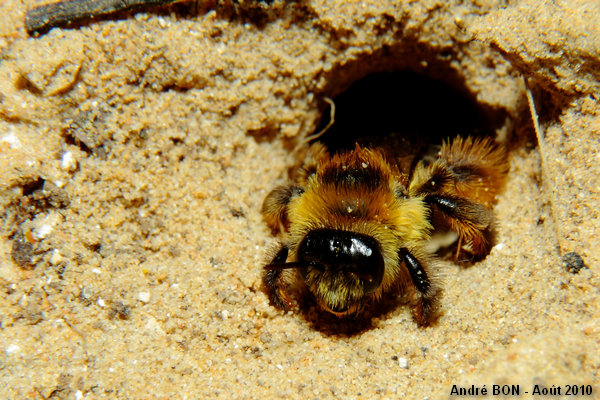

| Dasypoda hirtipes (Fabricius, 1793) |


|
|
Scientific name: Dasypoda hirtipes (Fabricius, 1793) Common name: Other names: Other scientific name: Dasypoda altercator. French name: Abeille à culottes Order: Hymenoptera Family: Melittidae Wingspan : 12-15 mm. Biotope: Sandy and sunny places for nesting areas, dunes, sand quarries, track sides. On Asteraceae to collect pollen. Geographic area: Palaearctic region south of the 60th parallel. Europe, North Africa, Asia. From western Europe to Japan. Observation period : Late July to September. |
You can recognize the solitary bees of the Dasypoda genus with the presence of two cubital cells on the upper wing and with the large pollen brushes located on the hind tibiae. The thorax and the head of Dasypoda hirtipes are circled with long brownish yellow hairs. The centre of the thorax is black. Tergites 2, 3 and 4 show white marginal edges. Males differ from females. They have rather thin legs, without pollen brushes. Dasypoda argentata has a long length of the malar area (between the eye edge and the mandible), longer than the pedicel (second antenna article). It gathers pollen on Dipsacaceae unlike of Dasypoda hirtipes which visits Asteraceae. Dasypoda cingulata visits Cistaceae. These two last species are much less common than Dasypoda hirtipes. There are also other species mainly with more southern ranges. Females dig galleries in the sand, sometimes forming large colonies. Each gallery is between 20 and 60 cm deep and ramifies towards several larva cells. Females come and go many times to store pollen into the cells. They carry it on the brushes they have on their hind legs. |
| [To know more about the Dasypoda hirtipes] [Next picture] [Top] |

|
This is my friend Gérard who has found some tenth of galleries, in the heart of the town, at a crossing located next to his home. The overall colony is quite visible because of the sand cones near the holes. The underground sand layers may appear at the surface here because of previous road works or this is may be the remaining part of a sand heap used for other purposes. You just need to stand still in wait next to the holes, stunned people passing by in the street, to observe these solitary bees coming and going. On this picture you can see the two cubital cells on the upper wings and the pollen brushes on the hind tibiae. I am rather confident about the Dasypoda genus but I am less confident about the species identification. However I know that Dasypoda hirtipes is much more common than the two other species. I could have concluded if I had observed them on flowers. |
| [To know more about the Dasypoda hirtipes] [Previous picture] [Top] |

|
I have not been able to shoot a picture where you can see the entire body of the bee. They are coming and going very fast. There is a common reflex to have when you see solitary bees next to their nest holes. You need to search for parasitic insects. My friend Gérard again helped me to observe one nice cuckoo wasp, Hedychrum nobile . Several of them were waiting near the holes of the galleries. I have then been able to add a new page with some pictures of this beautiful chrysididae. |